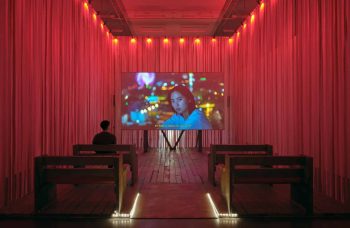Austria’s primary contemporary art fair, viennacontemporary, has found its niche and its value in a contemporary art market that is usually dominated massive galleries and ritzy, inaccessible fairs. The fair has a special focus on Central and Eastern European artists, and this year it put the spotlight on Armenian artists.
The fair went off in the last week of September, simultaneous to the Berlin Art Week and right before Frieze week in London.
The international art fair prides itself on its uniqueness as compared to other big art fairs. It gives a boost to small and medium-sized European galleries and it provides an internationally respected venue to artists in emerging markets.
The fair had an exceptional year. It attracted over 30,000 visitors to the Marx Halle in Vienna, surpassing the fair’s 2017 attendance figures. It boasted works from 118 galleries and institutions from 27 different countries, and it managed to attract the interest of local and international art collectors.
Vienna is having a renaissance of sorts in its contemporary gallery scene. While viennacontemporary was ongoing, it was reported that Berlin’s EXILE gallery would be relocating to Vienna. Prior to the fair’s start date, it was announced that the fair had secured its place at the Marx Halle for a decade in advance, after three successful editions.
Sophie Tappeiner, among Vienna’s new gallery owners, having opened her space in 2017, says the city has benefitted from rising costs of living in some of Europe’s other capitals, like in Berlin.
“They don’t need two or three jobs to survive here, like in New York or London, they can focus more on their practice.” She said, in reference to Vienna’s attractiveness for artist’s looking to concentrate on their work.
As viennacontemporary emphasizes its Central and Eastern European elements, in addition to its support of artists and gallerists from emerging economies, this year Armenian art was under the spotlight. The fair featured the work of 7 Armenian artists this year, dedicating some special attention to the country.
Sona Stepanyan, the Armenia Art Foundation’s curator, noted their foundation’s “amazing relationship with Vienna” that was a result of a 2003 exhibition of Armenian art at Vienna’s Kunsthalle.
Both artists based in Armenia and those artists that are a part of the diaspora were exhibited together in order to emphasize unity and a broader sense of the Armenian identity. Rebecca Topakian, one of the artists on display, grew up in France and only visited Armenia for the first time in 2016. In her exhibit, she printed family photographs onto natural glass and broken tuf, a building material used in Armenia.





